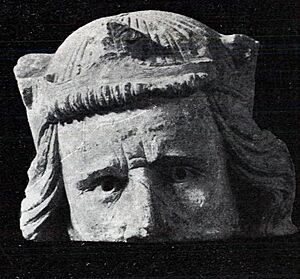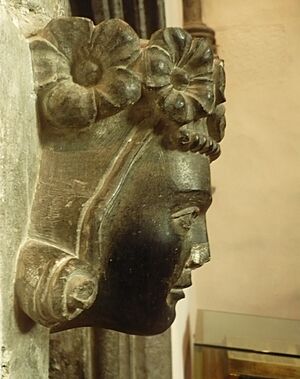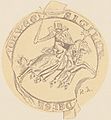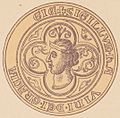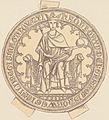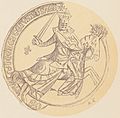Haakon V facts for kids
Quick facts for kids Haakon V Magnusson |
|
|---|---|
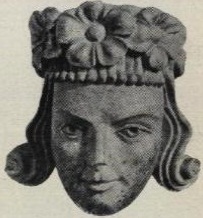
Contemporary bust of Haakon (as duke) from the Stavanger Cathedral, dated to the 1280s.
|
|
| King of Norway | |
| Reign | 15 July 1299 – 8 May 1319 |
| Predecessor | Eric II |
| Successor | Magnus VII |
| Born | 10 April 1270 |
| Died | 8 May 1319 (aged 49) |
| Burial | St Mary's Church, Oslo |
| Spouse | Isabelle de Joigny Euphemia of Rügen |
| Issue | Ingeborg, Duchess of Halland Agnes Haakonsdatter |
| House | Sverre |
| Father | Magnus VI of Norway |
| Mother | Ingeborg of Denmark |
Haakon V Magnusson (born April 10, 1270 – died May 8, 1319) was a powerful king of Norway. He ruled from 1299 until his death in 1319. King Haakon made many important changes during his time. He helped make Oslo the main city of Norway. He also built strong fortresses to protect the country.
Contents
Life of King Haakon V
Haakon was the younger son of King Magnus the Lawmender. His mother was Queen Ingeborg of Denmark. In 1273, Haakon's older brother, Eirik, became a junior king. This meant Eirik would rule alongside their father.
At the same time, Haakon was given the title "Duke of Norway." After his father died in 1280, Haakon ruled a large area. This included the region around Oslo and Stavanger. He was still under the rule of his brother, King Eirik. When King Eirik died without sons, Haakon became the new king.
Haakon's Marriages and Family
In 1295, Haakon married Isabelle, the daughter of Jean I, Count of Joigny. Sadly, she died in 1297, and they had no children. His first daughter was Princess Agnes Haakonsdatter.
In 1299, Haakon married for the second time. His new wife was Euphemia. She was the daughter of Vitslav II, Prince of Rügen. In 1301, they had a daughter named Ingeborg Håkonsdotter. Ingeborg later married Duke Eric Magnusson of Sweden. Their son, Magnus Eriksson, would later become king of Norway after Haakon V.
Changes During Haakon's Rule
During King Haakon's reign, Oslo slowly became the capital city of Norway. Before this, Bergen was the main city. Haakon also started building two very important fortresses. These were Akershus Fortress in Oslo and Bohus Fortress. These castles helped protect Norway.
King Haakon also worked to end wars with Denmark. In 1309, he made a peace agreement. This agreement brought an end to many years of fighting between Norway and Denmark.
At home, Haakon worked hard to make the king's power stronger. He tried to limit the power of the "magnates." These were powerful noble families who sometimes challenged the king. Haakon was very successful in this effort.
Succession and Burial
In 1319, King Haakon V died. His grandson, Magnus VII, became the next king. Magnus was still a baby when he became king. Haakon's daughter Ingeborg was made the official ruler for her young son.
King Haakon was buried in St. Mary's church in Oslo. Later, during excavations, the remains of two people were found. People believe these were Haakon and his wife Eufemia. Their remains were moved to the royal burial place at Akershus Castle.
Gallery
|
Haakon Magnusson
Cadet branch of the House of Hardrada
Born: 10 April 1270 Died: 8 May 1319 |
||
| Regnal titles | ||
|---|---|---|
| Preceded by Eric II |
King of Norway 1299–1319 |
Succeeded by Magnus VII |
See also
 In Spanish: Haakon V de Noruega para niños
In Spanish: Haakon V de Noruega para niños


